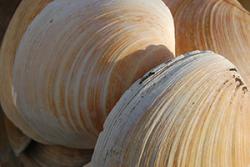Clams reveal secrets of changing marine climate
Marine scientists at �鶹��ý�����’s  are collecting useful information about climate change from an unlikely source – seashells.
are collecting useful information about climate change from an unlikely source – seashells.
, scientists who study growth rings on sea shells, are able to obtain a range of accurately dated information about the environment in which the sea shells grew. Much in the same way as dendochronologists age trees by counting the rings in a sawn tree trunk, the Bangor scientists can accurately age shells from the rings and growth layers embedded in the shells. Like trees, clam shells form one growth ring or layer each year and, as with trees, the rate of growth in any one year can be worked out from the width of the layer. More detailed analysis of the shell material can reveal a host of other information as well. By analysing different aspects of the chemical composition of the shell, the scientists are able to discern different characteristics of the environment in which it lived.
Using information, both from living shells and from other discarded shells from the sea bed, the team at �鶹��ý����� have been able to work out the water temperature of the ocean at the location the shells were collected. Because they also know the exact year when the shells were growing, they are able to build up a sea temperature record over long time periods.
Professors James Scourse and Chris Richardson, leading this research at the School of Ocean Sciences together with Dr Paul Butler and Dr David Reynolds commented: “Our research is providing unique data on the way in which climate change is influencing the ocean. What our technique offers is a means of revealing sea temperatures from year to year from the period before instrumental records were available.”
The shells used by the team in their research come from a species of clam called the Ocean Quahog (Arctica islandica). Growing in the cooler waters of the North Atlantic, and commercially used for fish bait and as an ingredient of clam chowder in some regions, these clams are extremely long-lived. The oldest shell that the team have aged had lived for 507 years.
The group are also interested in what biological mechanisms enable these long-lived clams to have such a long life-span.
This work was featured in a recently (26.9.13)
Publication date: 26 September 2013
